18.5.2 Intersection Approach Treatments
Managing potential conflicts with merging or crossing motor vehicle traffic is a fundamental challenge for bicyclists operating within bikeways at intersections. As a bikeway approaches an intersection, designers should aim to provide a continuous and direct route through the intersection, driveway, or alley that is recognizable to all users of the roadway. Designers should also aim to minimize or eliminate conflict areas and to maintain bikeway continuity up to and through an intersection, as intersections can be the most stressful locations for bicyclists to navigate.
Constrained environments may occur at intersections where additional motorist capacity is needed to accommodate turn lanes. Designers have several options when balancing bikeway designs with the need to accommodate turning traffic. Given the operational reality that bicyclists are operating on the right-side of the roadway as a slower, vulnerable roadway user, a key design influence is the interaction of bicyclists with right turning traffic and the geometric design of the intersection where this interaction occurs. The design of the intersection approach is influenced significantly by the bikeway design on the approach and departure of the intersection.
The following guidance covers the most common transition scenarios. For all scenarios described in this section, a high-comfort optional bicycle ramp to a sidewalk or protected intersection (see
) should be considered where the bikeway selection guidance in
indicates a need for additional separation and the existing condition is a shared lane, shoulder, or bicycle lane.
The following treatments are not presented in order of priority. The bikeway selection guidance of
should be used when evaluating intersection treatments in addition to the principals of
. It is preferable to provide the same level of accommodation as mid-block sections of a roadway.
18.5.2.1 Shoulder or Bicycle Lane Terminated to a Shared Through Lane
shows an intersection where a shoulder or bicycle lane is terminated because the roadway narrows or the lane becomes an additional through travel lane. The bicycle lane or shoulder should be dotted between 50 and 200-ft prior to the point where it ends to clarify this is a location where bicyclist must either merge into the traffic lane or where a bicycle ramp is provided with the option to exit to a sidewalk, separated bike lane, or sidepath. A BICYCLE warning sign (W11-1) or BICYCLES MERGE sign may be considered at the start of the dotted lane line followed by a BICYCLES ON ROADWAY or BIKES MAY USE FULL LANE sign. At locations with bicycle lanes, a BICYCLE LANE ENDS sign may be posted in lieu of a BICYCLES MERGING sign.

Figure 18-32: Example Shoulder or Bike Lane Terminating to a Shared Through Lane
(Refer to the
and
for additional signing and pavement marking guidance.)
18.5.2.2 Shoulder or Bicycle Lane Terminated to a Shared Right Turn Lane
Where there is insufficient space for a bike lane and a right turn only lane, designers must assess the risk to bicyclists when considering which of the following is a preferred option based on operational conditions at the location:
- Bike lane transitions to a shared right-turn lane ( );
- Bike lane transitions to a shared through lane ( );
- Bike lane transitions to a protected intersection ( ) or sidewalk via a bike ramp.
Shared lane markings may be located within the left side of the turn lane (
) if the lane is a minimum 14-ft, otherwise the shared lane markings should be located within the center of the right turn lane or located within the adjacent through travel lane (
) following
guidance. At locations where the lane is 15 or more feet in width, provision of a bicycle lane should be considered.
Designers should consider the volumes for each movement, the queuing length, time spent queuing, and operational speeds when determining if bicyclists should be placed in the through or right-turn lane.
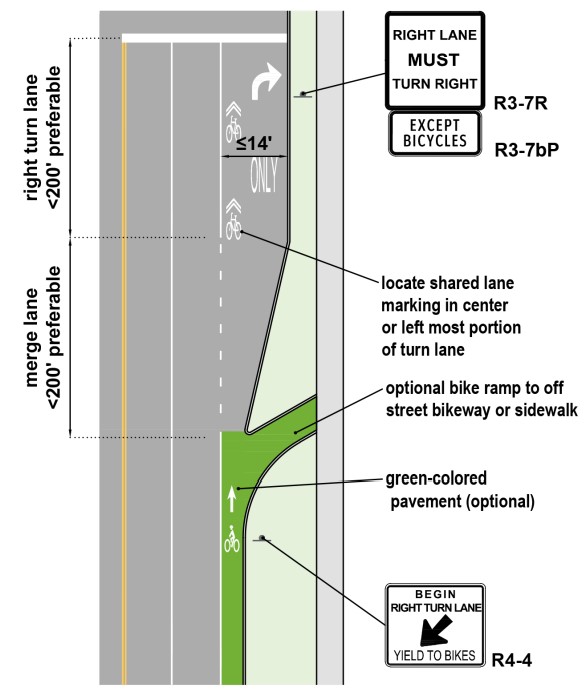
Figure 18-33: Example Bike Lane Transitions to a Shared Lane Markings in Right Lane
(Refer to the
and
for additional signing and pavement marking guidance.)
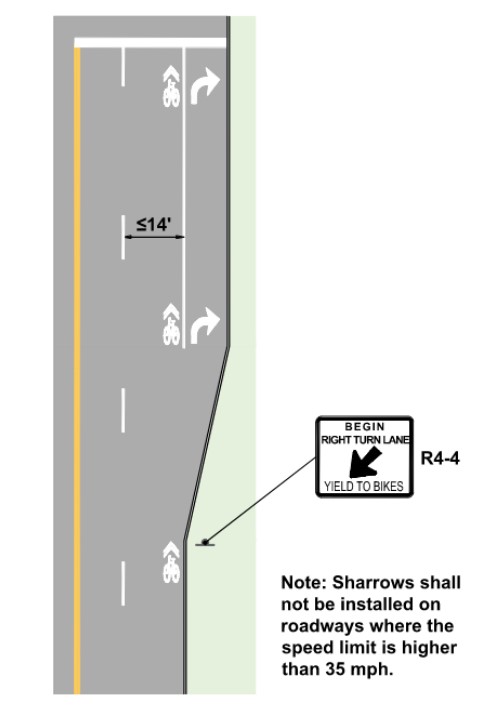
Figure 18-34: Example Bike Lane Transitions to a Shared Lane Markings in Through Lane
(Refer to the
and for
additional signing and pavement marking guidance.)
18.5.2.3 Shoulders and Bicycle Lanes Continue with Addition of Right Turn Lanes
shows an intersection where a through travel lane becomes a right turn only lane. In this scenario, the bike lane should shift to the left of the turn lane. The bike lane should remain along the curb until it is within 400-ft of the intersection. The bike lane drops at this point and is re-introduced on the left side of the right turn lane within 200-ft of the intersection.
In this scenario, the bike lane should not be striped diagonally across the travel lane, as this inappropriately suggests to bicyclists that they do not need to yield to motorists when moving laterally. Where operating speeds are less than 30 mph, shared lane markings may be used to delineate the likely path of travel of bicyclists transitioning across the shared lane between the bike lanes. A BICYCLE warning sign (W11-1) or BICYCLES MERGE sign should be placed where the curb side bike lane ends.
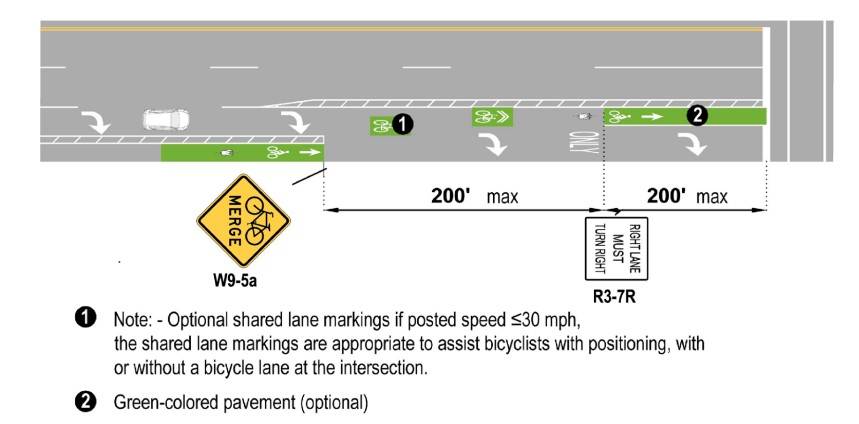
Figure 18-35: Bike Lane Transitions to Through Bike Lane with Right Turn Lane
(Refer to the
and
for additional signing and pavement marking guidance.)
shows an intersection that transitions a bike lane to a separated bike lane on the right side of right-turning vehicles. This may be desirable at locations where there are more than 150 right turning vehicles during the peak hour or an existing crash history. Signal phase separation of bicyclists and motorists should be considered with a bicycle signal. In this scenario, it is preferable the separated bike lane provide:
- A 6-ft bike lane width desirable exclusive of a gutter, 4-ft minimum; and
- A 6-ft buffer width desirable, 2-ft minimum.
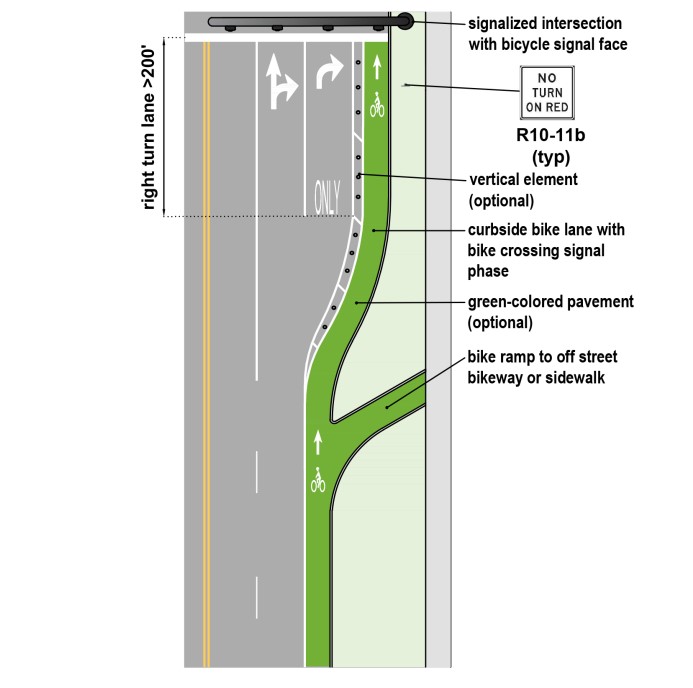
Figure 18-36: Example Bike Lane Approach to a Right Turn Only Lane
(Refer to the
and
for additional signing and pavement marking guidance.)
shows a right turn lane which requires drivers to physically cross the bike lane within a constricted area formed by vertical elements, such as medians or flexible delineators to force motorists to enter the turn lane at a clearly defined location, thus providing a more predictable conflict point. The opening must be designed to accommodate the desired motorist operating speed. A target speed of 35mph or less is preferred for the use of this design.
In this scenario it is preferable the separated bike lane provide:
- A 6-ft bike lane width desirable, 4-ft minimum; and
- A 2-ft minimum buffer width is required; otherwise provide maximized width bike lane ( ).
provides additional design options to accommodate bike lanes as they approach an intersection.
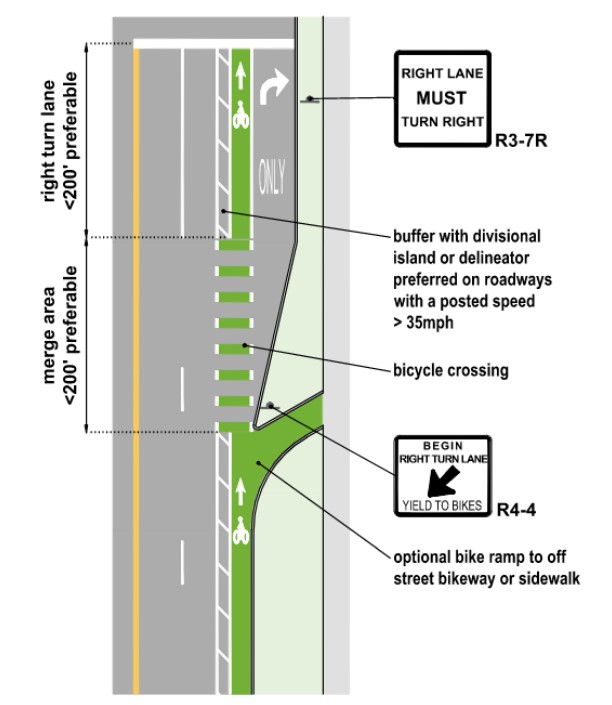
Figure 18-37: Bicycle Lane with Constricted Motorist Entry Point
(Refer to the
and
for additional signing and pavement marking guidance.)
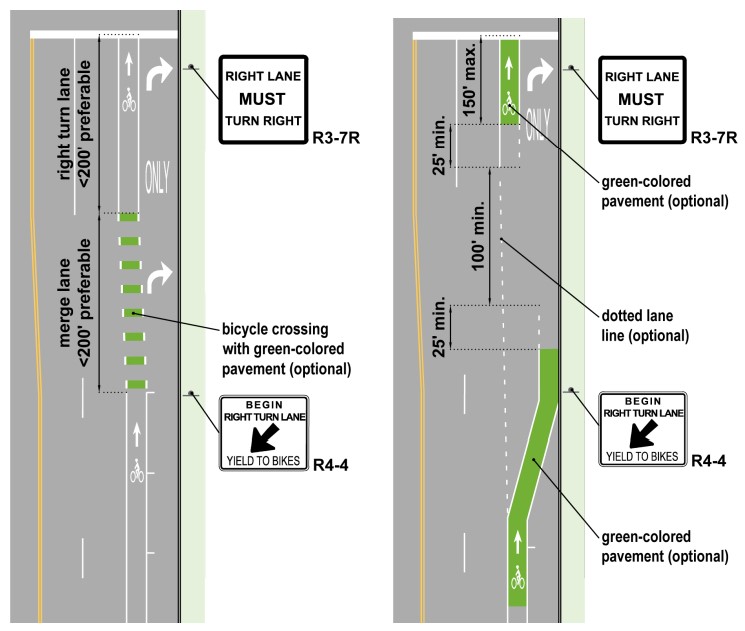
Figure 18-38: Standard Bicycle Lane with Right Turn Lane
(Refer to the
and
for additional signing and pavement marking guidance.)
18.5.2.4 Shoulder Transition to Bicycle Lane
Designers can transition a shoulder to a bicycle lane prior to intersections where it is desired to emphasize bicyclists have the ROW at the intersection as through moving vehicles, and then transition back to a paved shoulder on the far side of the intersection (
). Transitioning a paved shoulder to a bicycle lane at intersections may be desirable at locations near high-speed exit and entrance ramps (greater than 35 mph) where shoulders are the predominant bicycle accommodation in the area
Where shoulders are a part of a bike route, the striping should not taper towards the cross street at intersections, but it should transition to a dotted edge line where motorists are expected to use the shoulder to begin their turning movement (see
). The right edge of the shoulder for the turning roadway can be marked with a solid white line where delineating this edge is important for safety reasons
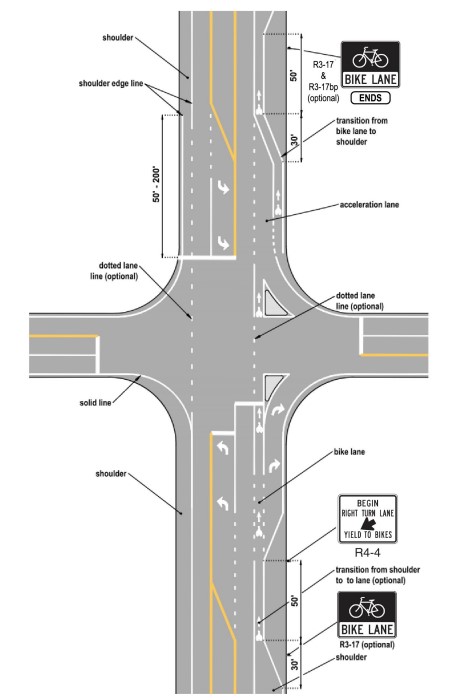
Figure 18-39: Example Shoulder Markings to Accommodate Bicycling
(Refer to the
and
for additional signing and pavement marking guidance.)
18.5.2.5 Shoulder Transition to Bicycle Lane at T-Intersections with Bypass Lanes
Bypass lanes at T‐intersections of two-lane roadways can be designed to facilitate the passing of motorists stopped to make left turns onto intersecting roads without encroaching into a bicyclists operating space (
). Where this is done on a roadway with paved shoulders, at least 4-ft of usable shoulder pavement clear of rumble strips should be carried through the intersection along the outside of the bypass lane and designated as a bike lane. At locations where guardrails are present, an additional 2-ft of shoulder width is recommended. This is especially critical on roadways with higher volumes and operating speeds where bicyclists operating on the shoulder are likely to be in conflict with traffic using the bypass lanes.

Figure 18-40: Motorist Bypass Lane with Bicycle Lane
(Refer to the
and
for additional signing and pavement marking guidance.)
18.5.2.6 Protected Intersection or Continuation of Separated Bike Lane or Sidepath
Protected intersections result from the application of a separated bike lane or sidepath up to the intersection (
). They may also be developed by transitioning a shared lane, shoulder, or bicycle lane into a separated bike lane or sidepath in advance of an intersection. They may be used at signalized and unsignalized intersections and driveways.
The defining features of protected intersections are a recessed bicyclist crossing and intersection corner geometry designed to slow right turning motorist speeds to improve motorist stopping or yielding to through moving bicyclists and parallel crossing pedestrians. Designers should aim to create an offset between the adjacent vehicle lane and the bike crossing between 6-ft and 16.5-ft from the adjacent motor vehicle lane. This treatment has been shown to significantly reduce crashes at uncontrolled and permissive conflict locations.
Additional guidance on protected intersections may be found at:
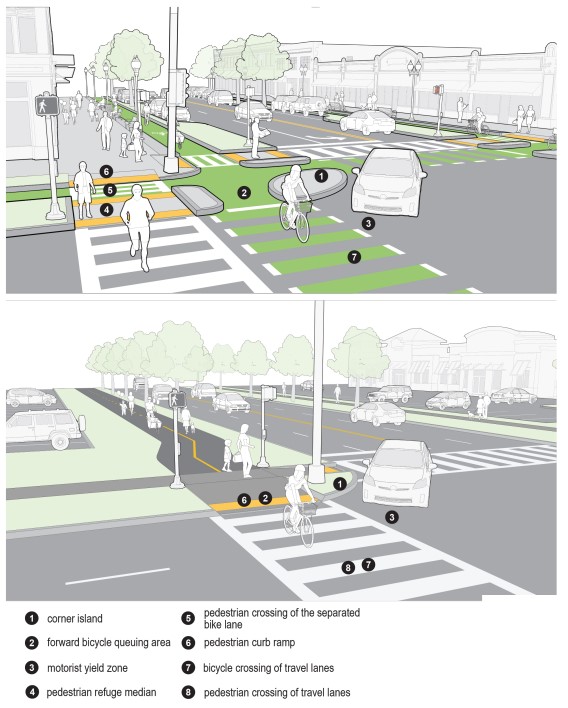
Figure 18-41: Protected Corner Treatment and Intersection Design Components
(Refer to the
and
for additional signing and pavement marking guidance.)
18.5.2.6.1 Corner Island
A key component of a protected intersection is the corner island, which provides the following benefits:
- Is used as a design control to set the horizontal offset between the adjacent motor vehicle lane and the bike crossing, to create a motorist stop or yield zone;
- Is used as a design control to slow turning vehicles to a desired turning speed in combination with truck aprons where necessary;
- Positions bicyclists waiting to cross in front of adjacent stopped motorists improving their visibility to motorists;
- Creates queuing space for bicyclists making a two-stage turn, outside of the path of through bicyclists; and
- Allows for a pedestrian refuge island, shortening their crossing and reducing exposure.
A corner island is a raised island between the bike lane and travel lane that defines the motorist’s turning radius and slows their turning speed. They are typically constructed using concrete and curbing. The corner island should be constructed with a standard vertical curb to discourage and prevent motor vehicle encroachment. In retrofit projects, they may be constructed with low-cost materials, such as paint and flexible delineator posts or engineered rubber curbs and/or rubber speed cushions.
shows details for corner islands in a protected intersection.
When on-street parking is located along the corridor, parking restrictions at intersection approaches will provide space for a street buffer to install a corner island. When there is no parking along the corridor, the bike lane can be offset away from the travel lane to create space for the desired corner island and motorist stop or yield zone. The corner island geometry will also impact the size of the motorist stop or yield zone and can be designed to slow approaching bicyclists’ speeds at the point of potential conflict by requiring some deflection of the bicyclists’ travel path. That deflection should generally not exceed the width of the bicycle lane.

Figure 18-42: Protected Intersection Treatments with Truck Apron
(Refer to the
and
for additional signing and pavement marking guidance.)
18.5.2.6.2 Truck Aprons
A truck apron is a design feature of some corner islands and is designed to accommodate the turning needs of large vehicles while slowing the turning speeds of smaller vehicles. The truck apron portion of the corner island is designed to be mountable by larger vehicles (the design vehicle) to accommodate their larger effective turning radius. The outside edge of the truck apron is constructed with a mountable curb (i.e., the interface between the pavement and truck apron) and should be designed for a passenger (P) or delivery vehicle (SU-30), to turn outside the apron at a slower speed.
below shows the larger vehicle’s effective turning radius traversing the truck apron and the passenger vehicle’s actual radius at the edge of the truck apron, noting that the bicycle stop bar (a.k.a., stop line) is located behind the larger vehicle turning path.
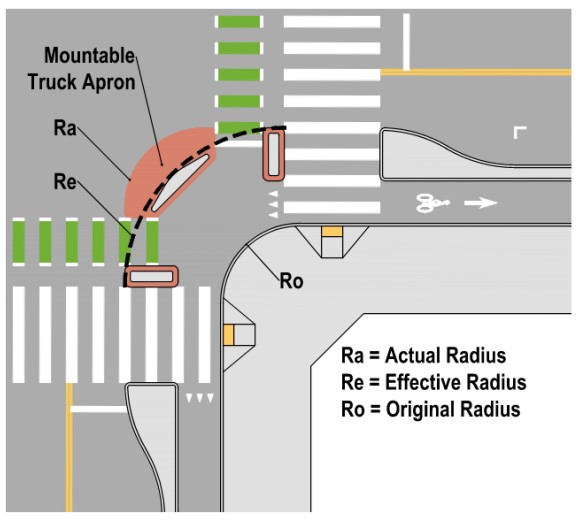
Figure 18-43: Actual vs Effective Radius
(Refer to the
and
for additional signing and pavement marking guidance.)
18.5.2.6.3 Pedestrian Considerations
When the street buffer is at least 6-ft in width, it may be used as a pedestrian refuge island, which shortens the crossing distance. In this case, pedestrians would cross the separated bike lane at an uncontrolled crossing, then cross the motor vehicle lanes as a separate crossing. When the crossing is located at a signalized intersection, the designer can consider reducing the signal timing for the pedestrian crossing to reflect this shorter crossing distance if the push buttons are located within the pedestrian refuge median. Stop bar markings (and associated R1-5b sign) and crosswalk markings should indicate the right of way between bicyclists and pedestrians at these locations.
below details various protected corner treatment methods.
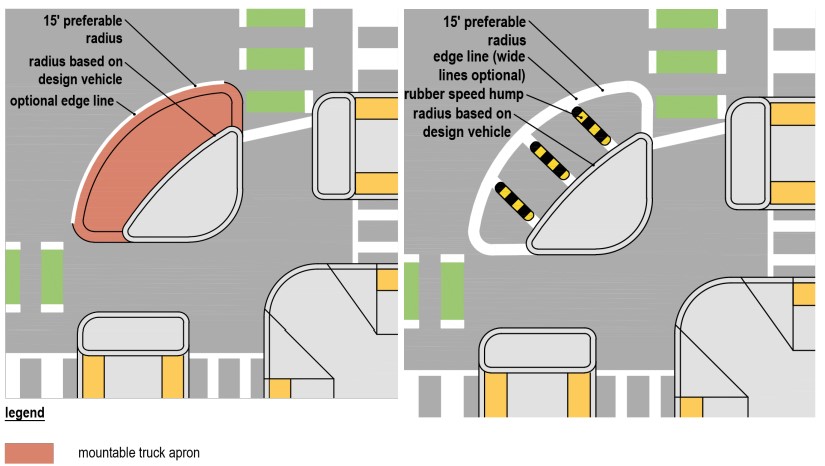
Figure 18-44: Protected Corner Treatment Details: Truck Apron (left) and Turning Wedge (right)
(Refer to the
and
for additional signing and pavement marking guidance.)
18.5.2.6.4 Traffic Control Considerations
At all intersections, the designer should consider using a TURNING VEHICLES YIELD TO PEDESTRIANS AND BICYCLES (R10-15) sign to communicate where turning motorists need to stop and yield to these street users. Use of a modified sign similar to the TURNING VEHICLES STOP FOR PEDESTRIANS (R10-15a) sign with a bicycle symbol may be considered.
In scenarios where a separated bike lane approaches an intersection that does not have adequate space for a protected intersection, the separated bike lane will have to transition to a bike lane or shoulder in advance of the intersection with a bicycle ramp.
18.5.2.7 Transitions from Protected Intersection to Other Bicycle Facility Types
When a protected intersection is provided for any bikeway type, the preference is for that protection to continue through the intersection and for the transition to a bikeway with less separation to occur on the far side of the intersection as shown below with the exception of sidepath transitions which require special considerations for pedestrians.
18.5.2.7.1 Transition from Separated Bike Lane to Shared Lane
It is preferable for the transition into a shared lane to occur after crossing a roadway to allow bicyclists time to stop and ascertain when it is safe to enter the roadway without conflict from approaching motorists who may be turning from the crossed roadway or approaching from the main roadway (
). Where this is not an option, the transition on the approach to the intersection should be in advance of the stop line on the roadway.
This location should ensure a clear sight line between all approaching motorists and the bicyclist. It may be desirable to add a BICYCLES MAY USE FULL LANE (R4-11) sign at the location where the bicyclist enter the roadway. A yield sign may be considered at the point where the bicyclists enters the roadway.
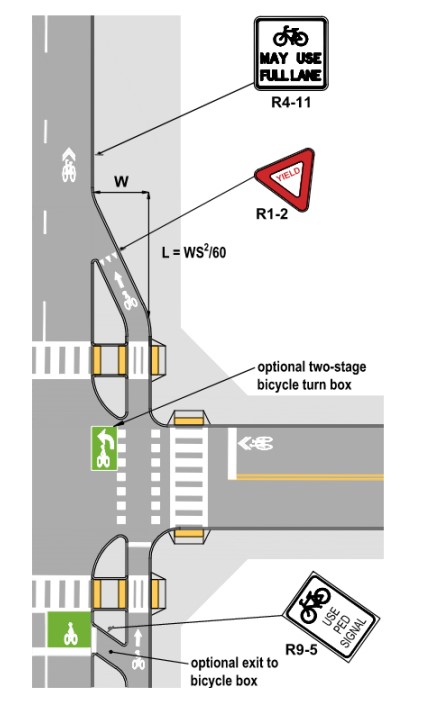
Figure 18-45: Transition to Shared Lane
(Refer to the
and
for additional signing and pavement marking guidance.)
18.5.2.7.2 Farside Transition from Separated Bike Lane to Bicycle Lane or Shoulder
The transition into a bicycle lane on the far side of the crossing may occur at any point after the bicyclist crosses the pedestrian crossing (
). This will minimize the pedestrian crossing of the roadway.
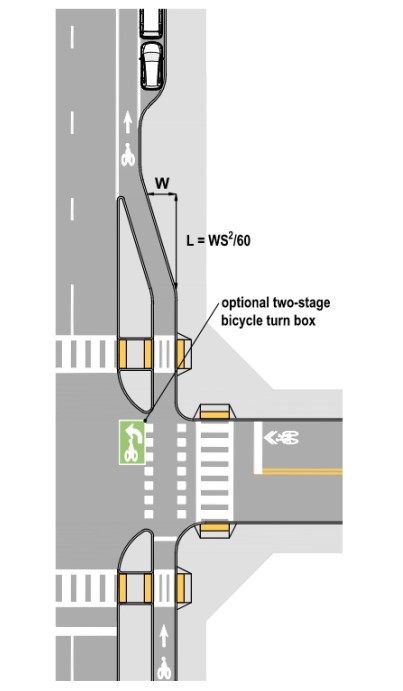
Figure 18-46: Transition to Bike Lane
(Refer to the
and
for additional signing and pavement marking guidance.)
18.5.2.7.3 Transitions from Two-Way Separated Bike Lanes to One-Way Separated Bike Lanes
Transitions of two-way separated bikeways into bikeways with one-way operation require additional considerations. Bicyclists operating in the contraflow direction will be required to cross at least two directions of travel and failure to provide a clear transition to the desired location may result in wrong way bicycle riding as shown in
and
. The crossing may warrant bicycle signals at signalized crossings (see
). The use of directional, tapered islands can provide positive direction for bicyclists to follow the desired transition route. It may also be desirable to use green-colored pavement within crossings and two-stage bicycle turn boxes to improve legibility and provide strong visual guidance of the intended path across the intersection to all users. The crossing may warrant bicycle signals at signalized crossings. The signal should be coordinated with the intersecting street signal phase.
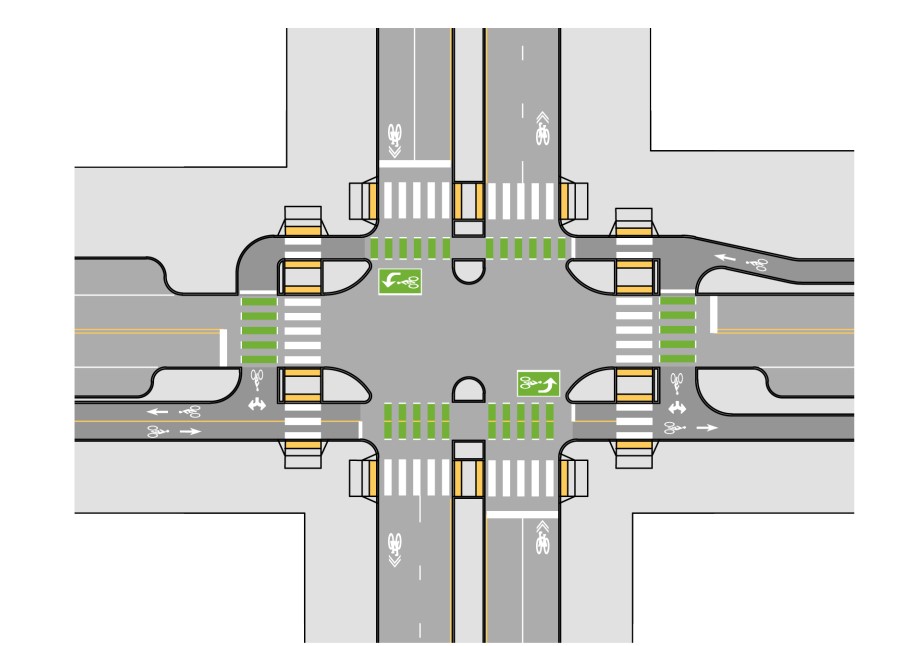
Figure 18-47: Transition from One-Way to Two-Way Separated Bike Lanes with Protected Intersection
(Refer to the
and
for additional signing and pavement marking guidance.)

Figure 18-48: Transition from One-Way to Two-Way Separated Bike Lanes with Protected Corner and Two-Stage Turn Queue Box
(Refer to the
and
for additional signing and pavement marking guidance.)
18.5.2.8 Raised Bike Lane Considerations at Intersections
At locations where bike lanes are raised and located adjacent to a travel lane, the raised bike lane must transition to street level into a bike lane or shared lane, or it must bend away from the travel lane into a sidewalk, sidepath, or separated bike lane (see
). It is preferable to transition the raised bike lane to bend away from the travel lane to form a protected intersection which minimizes conflicts with turning motorists. From the point where the bicycle lane shifts to become a separated bike lane, the design should follow the Protected Intersection Guidance in
(Option 1).
Where protected intersections are not feasible, the raised bike lane should transition to street level. At intersections with low volumes of right turning traffic (less than 50 per hour) or locations where a phase separated right turn lane is provided, it is preferable for the raised bike lane to continue to the intersection and return to street level on a ramp within 10-ft to 30-ft of a pedestrian crosswalk (Option 2).
Where it is determined to transition the raised bike lane to a right turn lane, standard bike lane or shared lane, that transition should occur between 50-ft to 200-ft prior to the intersection (Option 3). At locations with higher volumes of right turning traffic, a bike ramp should be considered to allow bicyclists to transition to the adjacent sidewalk or sidepath.
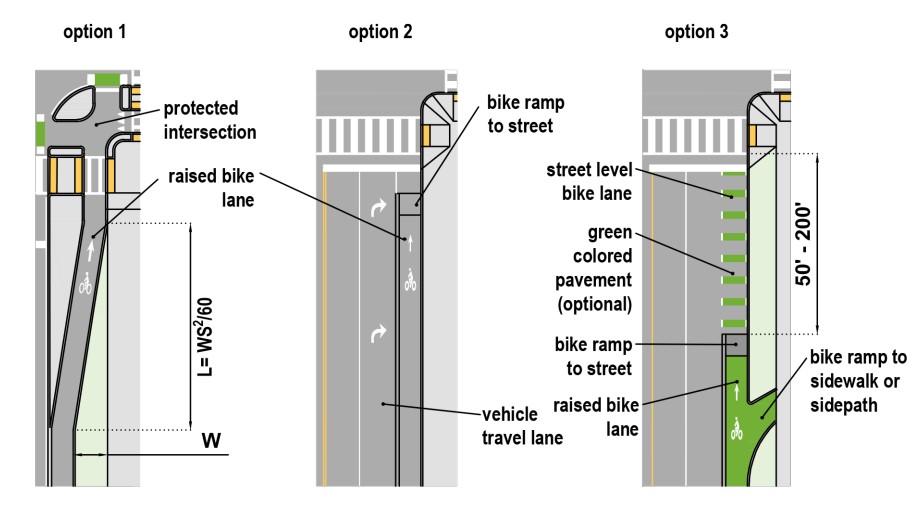
Figure 18-49: Raised Bike Lanes at Intersections
(Refer to the
and
for additional signing and pavement marking guidance.)